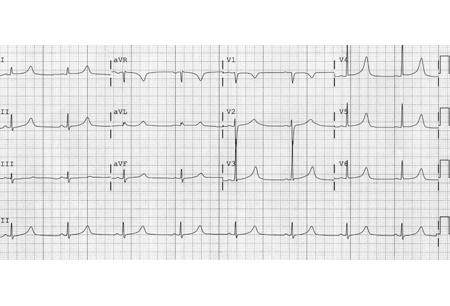Summary
Definition
History and exam
Key diagnostic factors
- history of known gene mutation
- use of drugs or circumstances known to increase the QT interval
- syncope during heightened adrenergic tones
- syncope during arousal or surprise
- arrhythmic symptoms postpartum
- syncope at rest and during bradycardia
- cardiac syncope
- palpitations
- periodic paralysis
- dysmorphic features
- sensorineural deafness
Other diagnostic factors
- dizziness
- angina
- fatigue
- oliguria
- muscle weakness
- tetany
- numbness
- Chvostek's sign
- Trousseau's sign
- cold and pale extremities
- hypotension
- confusion
Risk factors
- KCNQ1 gene mutations
- KCNH2 gene mutations
- SCN5A gene mutations
- QT interval-prolonging drugs
- hypokalemia
- hypomagnesemia
- hypocalcemia
- bradyarrhythmias
- central nervous system lesions
- female sex
- malnutrition
Diagnostic tests
1st tests to order
- ECG for LQT1
- ECG for LQT2
- ECG for LQT3
- ECG for hypokalemia and hypomagnesemia
- ECG for hypocalcemia
- ECG for complete atrioventricular (AV) block
- serum potassium
- serum magnesium
- serum calcium
Tests to consider
- Holter monitor
- exercise tolerance test
- echocardiography
- genetic testing
- epinephrine test
Treatment algorithm
acquired LQTS
congenital LQTS without previous cardiac event
congenital LQTS with previous cardiac event
Contributors
Authors
Mehmet K. Aktas, MD, MBA
Associate Professor of Medicine
University of Rochester Medical Center
Rochester
NY
Disclosures
MKA declares that he has received research grants from Astra Zeneca, Medtronic, and Boston Scientific. MKA has served as consultant for Abbott and Huxley Medical. MKA holds a patent for "ECG Clock Electrocardiogram Based Diagnostic Device and Method" (US patent #10,085,667). He is the author of a reference cited in this topic.
James P. Daubert, MD
Professor of Medicine
Duke University Medical Center
Duke Clinical Research Institute
Durham
NC
Disclosures
JPD declares that he has received honoraria for advisory boards, steering committees, data safety monitoring boards, events committees, and lecture fees from Abbott, Acutus Medical, Affera Inc., Biosense Webster, Biotronik, Boston Scientific, Farapulse, Gilead Sciences Inc., Medtronic, Microport, Phillips, and Vytronus; and research grants from Abbott, Biosense Webster, Boston Scientific, Farapulse, and Medtronic. He receives royalty payments from Wiley, Springboard and McGraw Hill for textbook authorship and educational materials. JPD declares that he has no stock, stock options, or other forms of ownership. He is the author of a reference cited in this topic.
Peer reviewers
Sami Viskin, MD
Director of Cardiac Hospitalization
Department of Cardiology
Tel Aviv Medical Center
Tel Aviv
Israel
Disclosures
SV declares that he has no competing interests.
Elizabeth S. Kaufman, MD
Associate Professor
Heart and Vascular Center
MetroHealth Campus
Case Western Reserve University
Cleveland
OH
Disclosures
ESK declares that she has no competing interests.
Peer reviewer acknowledgements
BMJ Best Practice topics are updated on a rolling basis in line with developments in evidence and guidance. The peer reviewers listed here have reviewed the content at least once during the history of the topic.
Disclosures
Peer reviewer affiliations and disclosures pertain to the time of the review.
References
Key articles
Zeppenfeld K, Tfelt-Hansen J, de Riva M, et al. 2022 ESC guidelines for the management of patients with ventricular arrhythmias and the prevention of sudden cardiac death. Eur Heart J. 2022 Oct 21;43(40):3997-4126.Full text Abstract
Priori SG, Wilde AA, Horie M, et al. HRS/EHRA/APHRS expert consensus statement on the diagnosis and management of patients with inherited primary arrhythmia syndromes. Heart Rhythm. 2013 Dec;10(12):1932-63.Full text Abstract
Wilde AAM, Semsarian C, Márquez MF, et al. European Heart Rhythm Association (EHRA)/Heart Rhythm Society (HRS)/Asia Pacific Heart Rhythm Society (APHRS)/Latin American Heart Rhythm Society (LAHRS) expert consensus statement on the state of genetic testing for cardiac diseases. Europace. 2022 Sep 1;24(8):1307-67.Full text Abstract
Roden DM. Clinical practice. Long-QT syndrome. N Engl J Med. 2008 Jan 10;358(2):169-76. Abstract
Al-Khatib SM, Stevenson WG, Ackerman MJ, et al. 2017 AHA/ACC/HRS guideline for management of patients with ventricular arrhythmias and the prevention of sudden cardiac death: a report of the American College of Cardiology/American Heart Association Task Force on clinical practice guidelines and the Heart Rhythm Society. Circulation. 2018 Sep 25;138(13):e272-391.Full text Abstract
Sauer AJ, Moss AJ, McNitt S, et al. Long QT syndrome in adults. J Am Coll Cardiol. 2007 Jan 23;49(3):329-37. Abstract
Schwartz PJ, Moss AJ, Vincent GM, et al. Diagnostic criteria for the long QT syndrome. An update. Circulation. 1993 Aug;88(2):782-4. Abstract
Schwartz PJ, Crotti L. QTc behavior during exercise and genetic testing for the long-QT syndrome. Circulation. 2011 Nov 15;124(20):2181-4.Full text Abstract
Reference articles
A full list of sources referenced in this topic is available to users with access to all of BMJ Best Practice.

Differentials
- Acquired structural heart disease
- Neurocardiogenic (vasovagal) syncope
- Neurologic syncope
More DifferentialsGuidelines
- European Heart Rhythm Association (EHRA)/Heart Rhythm Society (HRS)/Asia Pacific Heart Rhythm Society (APHRS)/Latin American Heart Rhythm Society (LAHRS) Expert Consensus Statement on the state of genetic testing for cardiac diseases
- 2022 ESC Guidelines for the management of patients with ventricular arrhythmias and the prevention of sudden cardiac death
More GuidelinesPatient information
Heart attack: what is it?
What you can do to prevent another heart attack
More Patient informationCalculators
QT Interval Correction
More CalculatorsLog in or subscribe to access all of BMJ Best Practice
Use of this content is subject to our disclaimer